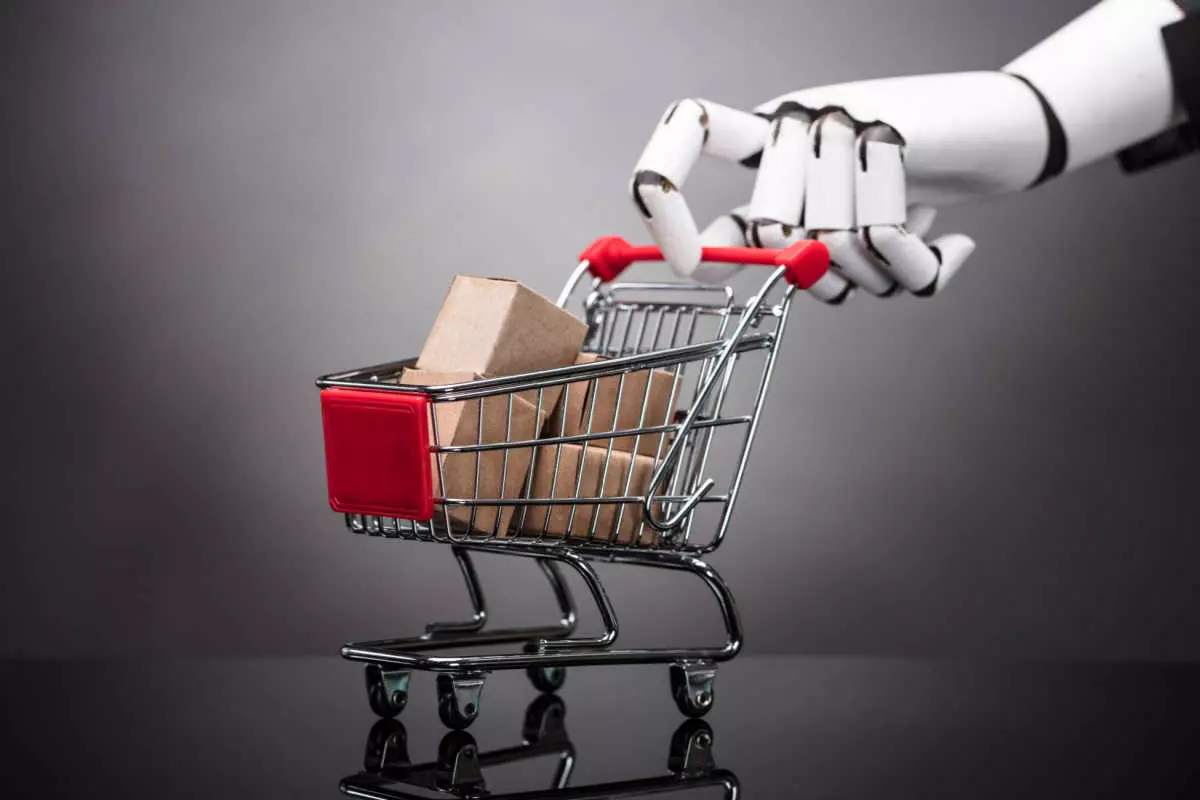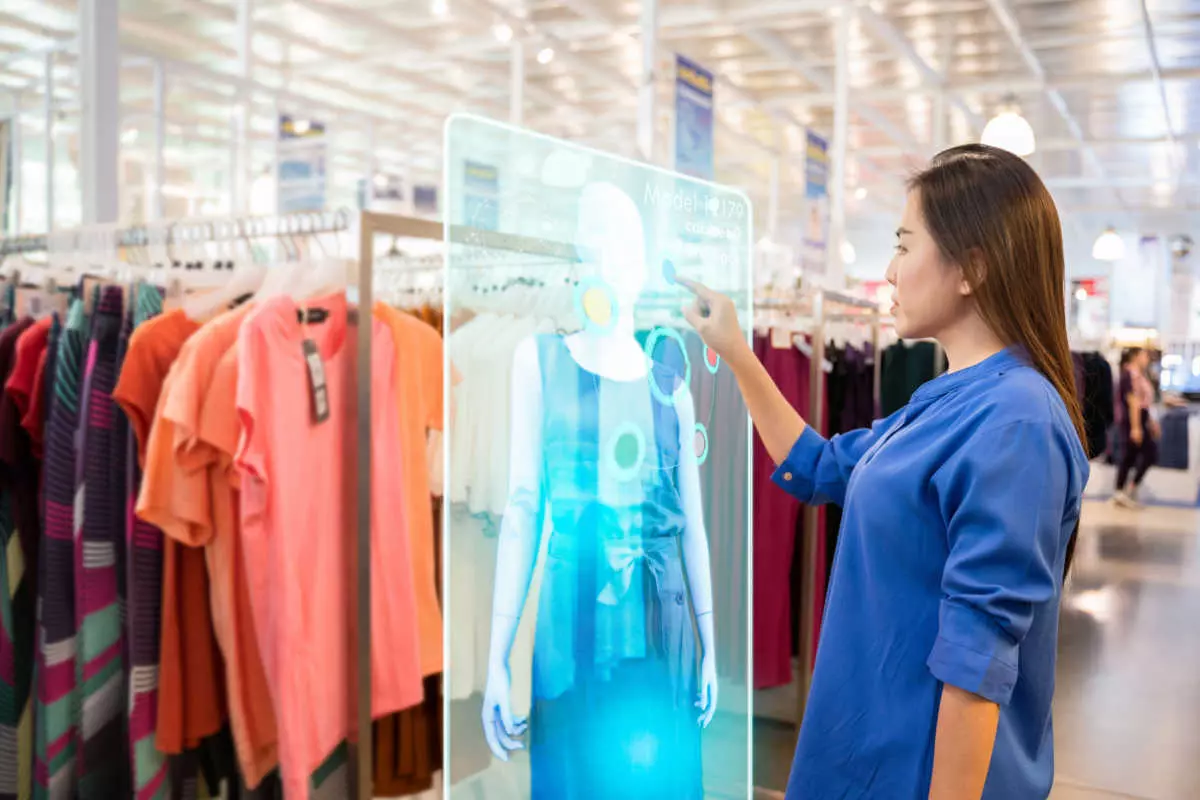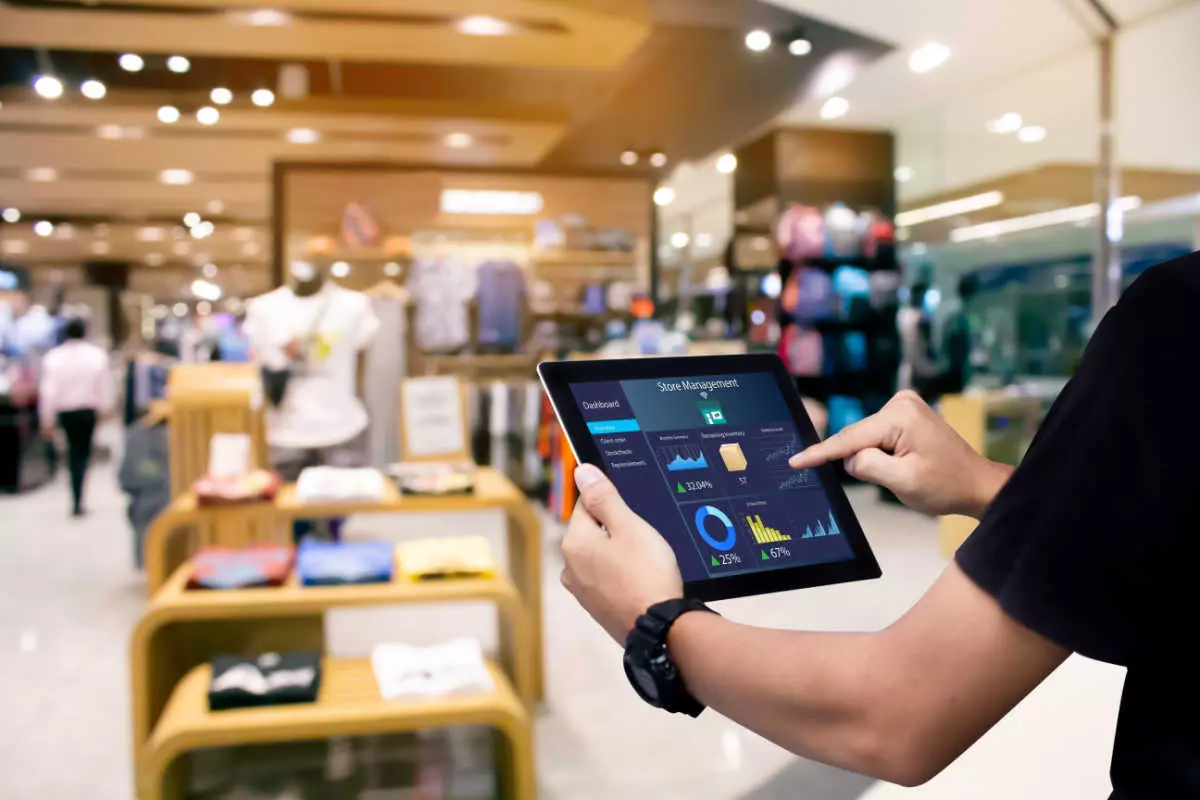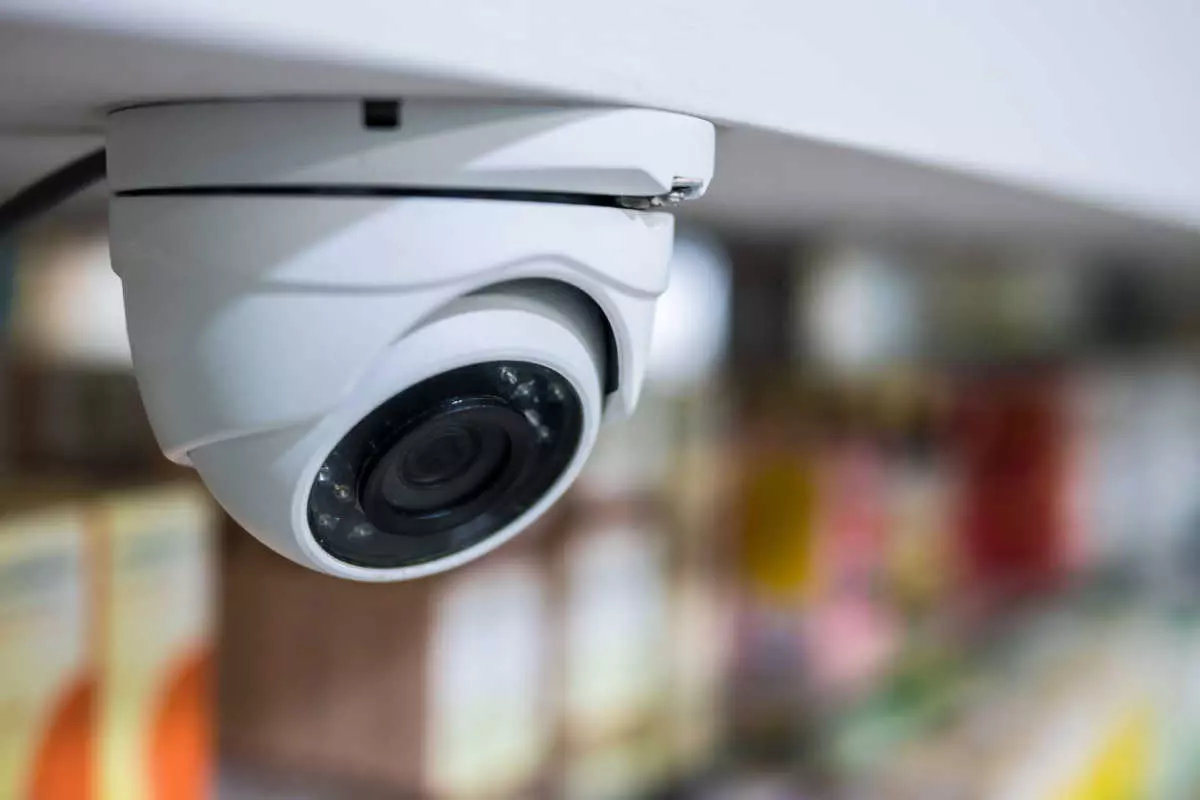The retail industry is undergoing a major transformation as technology plays a larger role in the way we shop and purchase goods.
In recent years, artificial intelligence (AI) has become a buzzword in the retail industry, and with good reason. AI has the potential to revolutionize the way retailers operate, from customer service to inventory management.
Join us as we uncover the exciting possibilities for the retail industry, including the ways AI creates more efficient, personalized, and engaging shopping journeys.
Benefits of AI in Retail
Utilizing AI in retail stores offers numerous benefits that can improve efficiency, customer satisfaction, and overall business performance.

Here are the top benefits of implementing AI in the retail industry:
- Personalized customer experiences: AI can analyze customer data to implement suggestive selling techniques, including customized product recommendations, targeted promotions, and tailored marketing campaigns. This can lead to higher customer satisfaction and increased sales.
- Enhanced inventory management: AI-powered systems can accurately predict demand, optimize stock levels, and identify trends. This reduces the risk of overstocking or stockouts and improves supply chain efficiency.
- Improved customer service: AI-driven chatbots and virtual assistants can handle routine customer queries and issues, offering instant support and freeing human staff to focus on more complex tasks and higher-value interactions.
- Dynamic retail pricing strategies: AI algorithms can analyze market trends, customer behavior, and competitor pricing to determine the optimal price for products and services.
- In-store navigation and product discovery: By integrating AI with augmented reality (AR) and computer vision, retailers can provide customers with real-time, in-store navigation and seamless product discovery experiences.
- Fraud detection and prevention: AI systems can quickly identify unusual patterns and potential transaction fraud, helping retailers reduce losses and protect their businesses from fraudulent activities.
- Workforce optimization: AI can analyze employee performance, schedules, and customer traffic to optimize staffing levels, ensuring the correct number of employees are available at the right time to serve customers effectively.
- Enhanced data analysis: AI-powered analytics can process vast amounts of data to conduct retail store audits. As a result, retailers can make informed decisions about marketing strategies, product assortments, and store layouts.
- Virtual fitting rooms: AI-driven fitting rooms allow customers to try on clothing and accessories virtually, offering a more convenient shopping experience.
How Is AI Used in Retail?
In the retail industry, AI is being leveraged to revolutionize various aspects of the shopping experience and optimize business operations. From personalized marketing to intelligent inventory management, AI is transforming the way retailers interact with customers and manage their resources.
Let’s explore some of the key applications of AI in retail and delve deeper into each area:
Personalized Suggestions
One of the most powerful applications of AI in retail is the ability to provide personalized suggestions. As a result, this enhances the shopping experience for customers and drives sales for retailers. AI achieves this by analyzing vast amounts of data, including consumer buying behaviors, browsing histories, and purchase patterns.

Machine learning algorithms process this information to identify individual preferences, tastes, and trends. In turn, retailers can offer highly relevant product recommendations and promotions tailored to each customer’s unique needs.
A popular example of AI-powered personalization is the recommendation engine used by Amazon. By tracking and analyzing user interactions, Amazon generates highly targeted customer suggestions, increasing the likelihood of a purchase and boosting overall sales.
Predictive Analytics for Supply Chain Management
AI predictive analytics has emerged as a game-changing tool in retail supply chain management. It enables businesses to optimize various aspects of their operations, from inventory management to pricing and promotional planning.
By leveraging machine learning algorithms and advanced data analytics, AI can process historical sales data, real-time market trends, and external factors. These factors include seasonal variations or economic indicators. In turn, AI generates accurate demand forecasts and informs strategic decision-making.
A prime example of AI-driven predictive analytics in supply chain management is Walmart’s utilization of machine learning algorithms. Walmart utilizes AI to improve inventory management and maintain optimal stock levels. This approach has allowed the retail giant to reduce stockouts, minimize excess inventory, and streamline its supply chain operations.
AI predictive analytics can also be employed in dynamic pricing strategies. For instance, retailers can analyze competitor pricing, market demand, and customer preferences to adjust prices in real-time, maximizing profits and maintaining a competitive edge.
Visual Search
AI is also making waves with its capabilities in visual searches, providing customers with a more intuitive and convenient shopping experience.
Imagine this: customers upload an image of a desired item. Then, the AI-powered system instantly analyzes the visual features, presenting consumers with similar products available in the store or online. This seamless process bridges the gap between inspiration and purchase, driving sales and customer satisfaction.
For example, Pinterest’s visual search tool, known as Lens, has successfully harnessed the power of AI to enable users to find visually similar items on the platform based on an uploaded image. This innovative technology has enhanced the user experience and created new opportunities for businesses to showcase their products.
Similarly, fashion retailers like ASOS have adopted AI-driven visual search tools, making it effortless for customers to discover clothing and accessories that match their preferences.
Chatbots
As trends in retail continue to evolve, AI chatbots have emerged as a powerful tool for enhancing customer service and streamlining communication.
These intelligent virtual assistants are powered by natural language processing and machine learning. They can handle various customer inquiries, from simple product questions to complex order-related issues. By offering instant, around-the-clock support, AI chatbots can significantly improve customer satisfaction and free up human staff to focus on higher-value tasks.

Consider H&M’s chatbot, which acts as a personal stylist. It offers product recommendations based on customer preferences and style choices. Similarly, Sephora’s chatbot assists customers in finding the perfect beauty products by answering questions, offering tutorials, and providing personalized product suggestions.
These AI-driven assistants improve the shopping experience and help retailers collect valuable customer insights to inform marketing and merchandising strategies.
However, remember to invest in ongoing chatbot training and optimization. This can be achieved by using customer feedback and interaction data to improve the chatbot’s performance and ensure it remains relevant and effective.
Cashier-Less Shopping
Imagine a world where customers walk into a store, pick up their desired items, and walk out without waiting in line or interacting with a cashier. This futuristic vision is quickly becoming a reality, thanks to AI-powered cashier-less shopping experiences that are transforming the retail landscape.
By leveraging computer vision, machine learning, and sensor fusion, retailers can offer frictionless shopping experiences, enhancing customer satisfaction and streamlining in-store operations.
One notable example of a cashier-less shopping experience is Amazon Go. Amazon uses AI-powered “Just Walk Out” technology to track customer selections and automatically charge their Amazon accounts upon exiting the store.
This groundbreaking concept has reduced checkout times and allowed retailers to allocate resources more efficiently by repurposing traditional cashier roles.
AR and VR
As the future of retail unfolds, the integration of AI with augmented reality (AR) and virtual reality (VR) is becoming one of the most exciting retail trends. AR and VR are immersive technologies that provide customers with interactive shopping experiences.
While AR vs. VR both offer unique and innovative experiences in retail, augmented reality (AR) superimposes digital content onto the user’s physical environment, enhancing their view of the real world. In contrast, virtual reality (VR) immerses users in a completely digital environment.

By combining AI’s data-driven insights with AR and VR’s visual and sensory capabilities, retailers can create personalized and engaging shopping experiences. As a result, this bridges the gap between physical and digital retail environments.
One notable example is IKEA’s AR app, IKEA Place, which uses AI to analyze user preferences and room dimensions. It allows customers to virtually place furniture in their homes to see how it looks and fits before purchasing.
In the fashion industry, brands like Tommy Hilfiger and Rebecca Minkoff have also adopted VR technology. These retailers provide customers with virtual runway shows and interactive dressing rooms, creating an exciting, immersive shopping experience.
Display Audits
AI is also revolutionizing in-store display audits, enabling retailers to optimize their store layouts, advertising efforts, and brand positioning with greater efficiency and accuracy.
AI-driven display audits can provide valuable insights into various aspects of retail merchandising, such as A/B testing, store layouts, and point-of-sale (POS) and point-of-purchase (POP) displays.
A/B Testing
A/B testing, also known as split testing, is a technique used by retailers to compare the effectiveness of two different variables, such as marketing strategies, website designs, or promotional offers.
A/B testing is conducted by exposing two variations (A and B) to a similar audience simultaneously and then measuring the difference in performance between the two options. Based on the A/B testing, retailers can determine which option yields better results.
Now, here’s where AI comes into play. By leveraging machine learning algorithms and advanced analytics, AI can significantly enhance the A/B testing process. In turn, AI-drive A/B testing can provide retailers with more accurate and actionable insights.
For example, AI can analyze vast amounts of data collected during the test, identify patterns and trends, and automatically adjust the variables to optimize the test’s outcome.
One use case of AI-driven A/B testing in retail is optimizing website layouts and navigation. By running an AI-powered A/B test on different homepage designs, retailers can determine which layout drives higher engagement, click-through rates, and conversions.
Another example is optimizing email marketing campaigns. AI can help retailers test various subject lines, call-to-actions, or promotional offers, to identify the best-performing combination for their target audience.
The benefits of using AI in A/B testing are numerous. First, AI can process large volumes of data much faster than traditional methods, allowing retailers to gain insights and make data-driven decisions more efficiently.
Second, AI-powered A/B tests can adapt in real time, meaning retailers can achieve better results in a shorter time frame. Finally, AI can help retailers uncover hidden patterns or trends that would have been overlooked, enabling them to fine-tune their marketing strategies and make more informed decisions.
Store Layouts
In-store layout audits use computer vision technology to monitor and analyze customer foot traffic patterns, product interactions, and dwell times.
These insights enable retailers to identify high-traffic zones, create more engaging product displays, and strategically place promotional materials to maximize their impact. A benefit of using AI for store layout audits is the ability to test and optimize cross-merchandising strategies.

By analyzing customer behavior data, AI-powered solutions can identify complementary products that are likely to be purchased together. As a result, retailers can design effective product pairings and displays that encourage impulse purchases and increase basket sizes.
POP and POS Displays
Point-of-sale (POS) displays refer to promotional materials or advertisements placed at or near the cash register to influence customer purchasing decisions during checkout.
On the other hand, point-of-purchase (POP) displays are promotional materials or displays strategically placed within the store to draw attention to specific products, offers, or promotions.
POS and POP displays are optimized using computer vision and machine learning algorithms to analyze shopper engagement data, such as gaze tracking and dwell time.
By processing this data, AI-powered systems can identify the most effective promotional materials, product placements, and pricing strategies, enabling retailers to fine-tune their point-of-sale advertising for maximum impact.
For instance, AI can analyze the effectiveness of various promotional materials and display designs, allowing retailers to A/B test different layouts and identify the best-performing options.
Another valuable use case for AI in optimizing POS and POP displays is real-time inventory management. For instance, AI-powered systems can monitor stock levels and product turnover, automatically adjusting display layouts and promotional materials to showcase high-demand or high-margin items.
This proactive approach helps retailers avoid stockouts, improve inventory turnover, and maximize sales opportunities.
Security
In line with the evolving retail industry trends, AI plays a crucial role in enhancing in-store and online security measures. This offers retailers innovative ways to protect their assets and customers.
By leveraging machine learning, computer vision, and data analytics, AI can significantly improve loss prevention, fraud detection, and cybersecurity. Consequently, this ensures a safer and more secure shopping environment.
Take, for instance, smart surveillance systems, which are AI-driven security measures used in retail stores. These systems can analyze real-time video footage to detect suspicious activities, such as shoplifting or unauthorized access to restricted areas. When the smart surveillance system detects suspicious activity, it alerts store personnel to take appropriate action.
A notable example is Walmart’s deployment of its Missed Scan Detection technology. This AI-driven solution identifies instances where items are not scanned properly at self-checkout stations, thereby reducing shrinkage and enhancing loss prevention efforts.

Online, AI-powered fraud detection tools can analyze vast amounts of data to identify and flag potentially fraudulent transactions, helping protect retailers and customers from financial loss.
These tools can detect anomalies and prevent unauthorized transactions in real time by examining transaction history, device fingerprinting, and behavioral patterns.
Case in point, e-commerce giant Amazon uses machine learning algorithms to analyze customer data and identify potential fraud. This minimizes the risk of chargebacks and account takeovers. In a similar vein, Mastercard’s Decision Intelligence platform employs AI algorithms to assess the risk of online transactions, reducing false declines and enhancing payment security.
Challenges of AI in Retail
Despite the numerous benefits that AI brings to the retail industry, there are several challenges that retailers must overcome to harness its full potential and shape the future of retail.
Some of the key challenges include the following:
- Implementation costs: Implementing AI solutions can be expensive, particularly for small and medium-sized retailers. The cost of AI platforms, data storage, infrastructure, and hiring skilled personnel, may pose financial challenges for some businesses.
- Data quality and availability: AI systems require vast amounts of high-quality data to function effectively. Retailers need to ensure that they have access to clean, accurate, and relevant data to feed into their AI algorithms. This may involve investing in data collection and storage infrastructure, as well as implementing data governance policies to maintain quality and integrity.
- Integration with existing systems: Integrating AI solutions with existing retail systems and processes can be complex and time-consuming. Retailers must ensure that their AI platforms are compatible with their current systems and can be seamlessly integrated to avoid disruptions to their operations.
- Security and privacy concerns: AI in retail often involves collecting and analyzing sensitive customer data, which can raise privacy and security concerns. Retailers must establish robust data protection policies and invest in cybersecurity measures to protect customer information and comply with relevant data protection regulations.
- Skill gaps and workforce training: Implementing AI solutions in retail often requires a workforce with specialized data science, machine learning, and analytics skills. Retailers may need to invest in training programs to upskill their workforce or hire new talent with the necessary expertise.
- Ethical considerations: Using AI in retail can raise ethical questions about fairness, transparency, and accountability. Retailers must consider these issues when implementing AI solutions and develop guidelines for ethical AI use to avoid potential pitfalls and negative consequences.
Final Thoughts
Undoubtedly, AI has the potential to revolutionize the retail industry by offering personalized customer experiences, optimizing supply chain management, and enhancing in-store operations.
As retailers embrace AI technology and overcome associated challenges, they can unlock new opportunities for growth, efficiency, and competitiveness in an ever-evolving market.


